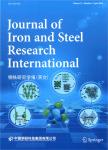Tensile behavior of ultrafine-grained low carbon medium manganese steel by intercritical annealing treatment
作者机构:School of Materials Science and EngineeringShanghai Jiao Tong UniversityShanghai 200240China Collaborative Innovation Center for Advanced Ship and Deep-Sea Exploration(CISSE)Shanghai 200240China Baosteel Research InstituteShanghai 201900China
出 版 物:《Journal of Iron and Steel Research International》 (Journal of Iron and Steel Research, International)
年 卷 期:2020年第27卷第12期
页 面:1433-1445页
核心收录:
学科分类:08[工学] 080502[工学-材料学] 0805[工学-材料科学与工程(可授工学、理学学位)]
基 金:supported by the Joint Research Center for Future Iron and Steel,SJTU&Baosteel The author(L.M.Fu)is grateful to the financial support from Startup Fund for Youngman Research at SJTU(SFYR at SJTU,No.18X100040023)
主 题:Ultrafine-grained dual-phase ferrite-austenite medium-Mn steel Annealing Deformation behavior Transformation-induced plasticity effect Back stress hardening
摘 要:The intercritical annealing treatment at 650 and 700 ℃ results in two ultrafine-grained (UFG) dual-phase ferrite-austenitesteels. The two steels exhibit different and special discontinuous yielding and pronounced Lüders-like strain phenomenawith large yielding strain which are related to their retained γ-austenite (RA) volume fractions and RA stabilities. The steelannealed at 650 ℃ shows an absent or very small strain hardening, while the steel annealed at 700 ℃ shows an obviousstrain hardening upward curvature with increasing strain. The results show that before and during straining, the steel annealedat 650 ℃ exhibits a mixture of equiaxed and elongated UFG α-ferrite and austenite phases;however, the steel annealed at700 ℃ exhibits only elongated UFG α and γ phases. It was found that most of the γ-austenite to α′-martensite transformationoccurred at the initial deformation stage and very small or almost no transformation occurred afterward. This demonstratesthat the strain-induced martensite (SIM) transformation (γ-α′) or transformation-induced plasticity (TRIP) effect dominatesonly at the initial deformation stage. RA remained stable, and no TRIP effect was observed at the final deformation stage. Theload-unload-reload test was performed to evaluate the back stress (σb) hardening effect. It is believed that the pronouncedstrain hardening behavior at the later deformation stage is mainly associated with σb enhancement induced by the strainpartitioning between the soft and hard phases due to SIM transformation during tensile deformation.



